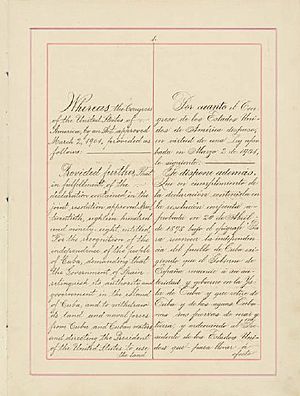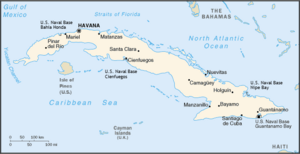Cuban–American Treaty of Relations (1903) facts for kids

Page one of the 1903 Treaty of Relations, including the Platt Amendment
|
|
| Signed | May 22, 1903 |
|---|---|
| Location | Havana |
| Effective | July 1, 1904 |
| Expiry | June 9, 1934 |
| Signatories |
|
| Citations | 33 Stat. 2248; TS 437; 6 Bevans 1116 |
| Also known as the Permanent Treaty (6 Bevans 1126). Amended by supplementary convention of January 20, 1903 (TS 438; 6 Bevans 1123). Abrogated by the Treaty of Relations of 1934 on June 9, 1934 (TS 866; 6 Bevans 1161). | |
The 1903 Cuban–American Treaty of Relations (Spanish: Tratado Cubano–Estadounidense) was an important agreement between the newly formed Republic of Cuba and the United States. It was signed on May 22, 1903. This treaty allowed the U.S. to lease land in Guantánamo Bay. This land was to be used for naval and coaling stations. Two separate agreements for these leases were made in February and July of the same year.
Contents
Understanding the 1903 Treaty of Relations
The United States had a law called the Platt Amendment. This law said that the U.S. would only give control of Cuba back to its government if Cuba agreed to seven specific rules. These rules were added to Cuba's constitution on June 12, 1901.
Why the Treaty Was Needed
The Platt Amendment rules limited Cuba's independence. They also gave the U.S. the right to watch over and sometimes get involved in Cuban affairs. Cuba's government took power, and the U.S. military left on May 20, 1902. The last rule of the Platt Amendment said that all its other rules must also be put into a treaty. The Treaty of Relations, signed in May 1903, made this happen.
How the Treaty Was Used
The 1903 Treaty of Relations was later used to justify the Second Occupation of Cuba. This happened from 1906 to 1909. On September 29, 1906, William Howard Taft, who was the U.S. Secretary of War and later a U.S. president, started this occupation. He set up a temporary government in Cuba, following the rules of the treaty. He declared himself the temporary Governor of Cuba. President Roosevelt approved this order on October 23, 1906.
When the Treaty Ended
The 1903 Treaty of Relations was later replaced by the 1934 Treaty of Relations. The 1934 treaty mostly ended the 1903 agreement. However, it still allowed the U.S. to lease land for a naval station. It also continued to protect the U.S. from blame for actions taken before Cuba became a republic in 1902.
The 1903 Lease Agreements
The 1903 Treaty of Relations talked about leasing land. One lease was signed in February 1903. Another was signed in July 1903.
Details of the February 1903 Lease
The lease agreement from February 16–23, 1903, stated that Cuba would lease specific lands to the United States. This included the land around Guantánamo Bay. The purpose was for coaling and naval stations, for as long as needed. The lease said the U.S. "shall exercise complete jurisdiction and control" over these areas. However, it also recognized that Cuba would keep its "ultimate sovereignty." Cuban trading ships could pass freely through these waters. The U.S. also had the right to change the waters as needed.
Details of the July 1903 Lease
Under the lease treaty signed on July 2, 1903, the U.S. agreed to pay the Cuban government $2,000 in gold each year. After 1934, the U.S. stopped using the gold standard. So, lease payments were changed to a check backed by paper money.
The payment due on July 2, 1974, was $4,085. Because of inflation, $2,000 from 1903 would be worth much more today. However, the payment has remained at $4,085. Since the Cuban Revolution, the Cuban government has only cashed one of these checks. This happened early in the revolution due to "confusion." The other checks, made out to a position that no longer exists, were once shown in a desk drawer during a television interview.
Different Views on the Treaty
United States' Perspective
The treaty did not give the United States everything it originally wanted. The U.S. government and its military in Cuba wanted to lease four areas. These were Guantánamo Bay, Bahia Honda, Cienfuegos, and Nipe Bay. They only ended up leasing two.
Cuba's Perspective
The government of Cuba believes the base is an insult to its independence. They argue it was taken under pressure and kept by force. Cuba has also raised concerns about activities at the base. The lease does include a rule for both sides to return people who are fleeing justice.
Professor Alfred-Maurice de Zayas, who is Cuban-American, has suggested that the lease might no longer be valid. He points out that the February 1903 lease says the U.S. can only use the land for "coaling or naval stations only, and for no other purpose." He questions if a prison facility meets these rules.
See also
 In Spanish: Tratado cubano-estadounidense para niños
In Spanish: Tratado cubano-estadounidense para niños
- Cuba–United States relations
- 1873 Dominican Republic Samaná Peninsula referendum


